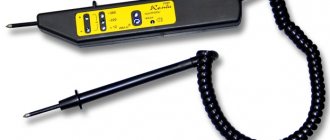Technical events
When preparing the workplace with stress relief, the following technical measures must be carried out in the specified order:
- the necessary shutdowns have been made and measures have been taken to prevent the supply of voltage to the work site due to erroneous or spontaneous switching on of switching devices;
- prohibiting posters must be posted on manual drives and on remote control keys of switching devices;
- checked that there is no voltage on live parts that must be grounded to protect people from electric shock;
- grounding is applied (grounding blades are included, and where they are absent, portable grounding connections are installed);
- “Grounded” signposts have been posted, workplaces and live parts that remain energized have been fenced off if necessary, and warning and instructional posters have been posted.
I think anyone can learn this passage. There is nothing complicated here, the main thing is to understand the meaning of the text. Remember this short plan for yourself:
- the first action is to turn off and take measures to prevent it from turning back on;
- hanging posters;
- checking for lack of voltage;
- application of portable grounding;
- hanging directional and warning posters, if necessary, fencing the workplace and those live parts that remain energized.
I found a cool video on YouTube that will help you in the learning process.
This passage should be completely sufficient to answer the question in the exam. But just in case, you can read the rest of the rules to refresh the knowledge in your head.
How is an outfit registered?
Before starting work, the permitter must register a new permit for work in electrical installations. The document is assigned a number by which it is entered in the work order logbook.
In addition to the number, the logbook indicates the location of the work, the name of the work, the end date and start date of the activity.
When the clearance order is received, the permitter is required to obtain clearance from the senior operating personnel who control the electrical equipment.
That is, you can prepare the workplace and admit the team only when the permit has already been issued. It is issued not only by senior operational personnel, but also by an authorized employee of the enterprise, for example, a shift foreman of the operational service or a senior foreman.
The permit may be issued orally or by telephone. After permission to work independently in an electrical installation has been given the go-ahead, the corresponding chapter in the work order is filled out. The details of the employee who authorized the work, his position, time and date of issue of the permit are indicated. In addition, you need to provide information about the employees who will carry out activities on the site.
3.1. Shutdowns
3.1.1. When preparing the workplace, the following should be disabled:
- live parts on which work will be carried out;
— unfenced live parts, to which people, machinery and lifting machines may accidentally approach at a distance less than that specified in Table 1.1;
- control and power circuits of the drives, the air in the control systems of switching devices is closed, the springs and weights of the drives of switches and disconnectors are removed.
3.1.2. In electrical installations with voltages above 1000 V, there must be a visible gap on each side from which voltage can be supplied to the workplace by the switching device. A visible break can be created by opening disconnect switches, removing fuses, opening isolators and load switches, and disconnecting or removing busbars and wires.
Power transformers and voltage transformers associated with the section of the electrical installation allocated for work must be disconnected and their circuits must also be disassembled from their other windings to eliminate the possibility of reverse transformation.
3.1.3. After disconnecting switches, disconnectors (isolators) and manually operated load switches, you must visually verify that they are disconnected and that there are no bypass jumpers.
3.1.4. In electrical installations with voltages above 1000 V, to prevent erroneous or spontaneous switching on of switching devices that can supply voltage to the place of work, the following measures must be taken:
for disconnectors, separators, load switches, manual drives in the off position must be locked with a mechanical lock (in electrical installations with a voltage of 6-10 kV with single-pole disconnectors, instead of a mechanical lock, it is allowed to put dielectric caps on the knives);
for disconnectors controlled by an operating rod, stationary fences must be locked with a mechanical lock;
For drives of switching devices that have remote control, the power circuits and control circuits must be turned off, and for pneumatic drives, in addition, the valve on the compressed air supply pipeline must be closed and mechanically locked and the compressed air must be released, while the drain valves must be left in the open position;
for load and spring drives, the closing weight or closing springs must be brought to the non-working position;
Prohibition posters must be posted.
Measures to prevent erroneous switching on of switchgear switching devices with withdrawable trolleys must be taken in accordance with paragraphs. 4.6.1, 4.6.2 of these Rules.
3.1.5. In electrical installations with voltages up to 1000 V, the voltage must be removed from all live parts on which work will be carried out by disconnecting manually operated switching devices, and if there are fuses in the circuit, by removing them.
If there are no fuses in the circuit, prevention of erroneous switching on of switching devices must be ensured by such measures as locking handles or cabinet doors, closing buttons, installing insulating pads between the contacts of the switching device, etc. When removing voltage from a switching device with a remote control, it is necessary to open the secondary circuit of the switching coil .
The listed measures can be replaced by disconnecting or disconnecting the cable or wires from the switching device or from the equipment on which work is to be carried out.
Prohibition posters must be posted.
3.1.6. The disconnected position of switching devices with voltages up to 1000 V with contacts inaccessible for inspection is determined by checking the absence of voltage at their terminals or at the outgoing busbars, wires or terminals of the equipment included by these switching devices.
How are the works completed?
After the instruction has been completed, the table in the work permit form for work in electrical installations is filled out. It indicates the workplace, time, date, signatures of the work producer and the permitter.
The permit must be in two copies. The exception is those cases when the order is issued by telephone. One form is kept by the producer of the work, and the other by the person admitting it.
After all the nuances are met, the team can begin work.
3.2. Hanging prohibition posters
3.2.1. On the drives (drive handles) of manually controlled switching devices (switches, separators, disconnectors, knife switches, automatic machines), in order to avoid the supply of voltage to the workplace, posters “Do not turn on! People are working."
For single-pole disconnectors, posters are hung on the drive of each pole, for disconnectors controlled by an operating rod - on the fences. On the valves that block air access to the pneumatic drives of the disconnectors, a poster “Do not open! People are working."
At connections with voltages up to 1000 V that do not have switching devices, the poster “Do not turn on! People are working” must be posted near the removed fuses, in the switchgear - in accordance with clause 4.6.2 of these Rules.
Posters must be posted on keys and buttons of remote and local control, as well as on automatic machines or at the location of removed fuses of control circuits and power supply circuits of switching device drives.
3.2.2. On the drives of disconnectors that are used to turn off overhead lines or cable lines for work, regardless of the number of working crews, one poster “Do not turn on! Work on the line." This poster is hung and removed at the direction of the operational personnel who keep track of the number of crews working on the line.
Primary admission
How is the initial admission of workers to work in electrical installations? The primary approval is the one when electricians carry out work on a structure for the first time.
In order to begin activities, you must obtain a work permit. This is the name given to a task for the production of work, which is drawn up on a specific form. This form has a prescribed form and determines the content, start and end times of work, location, composition of workers and crews, conditions for safe conduct, and those responsible for safe activities.
3.3. Checking for no voltage
3.3.1. It is necessary to check the absence of voltage with a voltage indicator, the serviceability of which must be established before use using special devices intended for this purpose or by approaching live parts that are known to be energized.
In electrical installations with voltages above 1000 V, it is necessary to use dielectric gloves when using the voltage indicator.
In electrical installations with a voltage of 35 kV and above, to check the absence of voltage, you can use an insulating rod by touching it several times to live parts. A sign of lack of tension is the absence of sparking and crackling. On single-circuit overhead lines with a voltage of 330 kV and above, a sufficient sign of the absence of voltage is the absence of corona.
3.3.2. In the switchgear, one employee from among the operating personnel is allowed to check the absence of voltage, having group IV - in electrical installations with voltages above 1000 V and having group III - in electrical installations with voltages up to 1000 V.
On overhead lines, the absence of voltage must be checked by two workers: on overhead lines with voltages above 1000 V - workers with groups IV and III, on overhead lines with voltages up to 1000 V - workers with group III.
3.3.3. It is allowed to check the absence of voltage by checking the circuit in situ:
in outdoor switchgear, switchgear and package transformer substations, as well as on overhead lines during fog, rain, snowfall in the absence of special voltage indicators;
in outdoor switchgear with a voltage of 330 kV and higher and on double-circuit overhead lines with a voltage of 330 kV and higher.
When calibrating the circuit in situ, the absence of voltage at the inputs of overhead lines and cable lines is confirmed by the person on duty, in whose operational control the lines are located.
Verification of overhead lines in kind consists of checking the direction and external signs of the lines, as well as the designations on the supports, which must correspond to the dispatcher names of the lines.
3.3.4. On overhead lines with a voltage of 6 - 20 kV, when checking the absence of voltage, carried out from wooden or reinforced concrete supports, as well as from telescopic towers, with an indicator operating on the principle of capacitive current flow, with the exception of pulsed current, the required sensitivity of the indicator should be ensured. To do this, its working part must be grounded.
3.3.5. On overhead lines, when hanging wires at different levels, check the absence of voltage with a pointer or rod and install grounding from bottom to top, starting from the bottom wire. With a horizontal suspension, the check should begin with the nearest wire.
3.3.6. In electrical installations with voltages up to 1000 V with a grounded neutral, when using a two-pole indicator, it is necessary to check the absence of voltage both between the phases and between each phase and the grounded equipment body or protective conductor. It is allowed to use a previously tested voltmeter. The use of control lamps is prohibited.
3.3.7. Devices signaling the switched-off position of the device, blocking devices, constantly switched on voltmeters, etc. are only additional means confirming the absence of voltage, and based on their readings one cannot draw a conclusion about the absence of voltage.
New rules for issuing work orders
If previously it was necessary to fill out a work permit to work in electrical installations, now you can submit the document by e-mail. True, it will still need to be printed in the same number of copies. Even due to changes in the rules, it remains necessary to fill out all the fields. Instead of a signature, you need to put the initials of the person who authorized the work and his position.
The document is signed by the employee who filled in the blank lines. The rules allow the appointment of an admitter and an observer as one person. In this case, the team’s permit to work in electrical installations is issued in duplicate. The document is valid for fifteen days. It can be extended only once and also for fifteen days. In case of interruptions in work, the work order is valid until the end of its term.
The person who filled out the form from the very beginning, or another employee who has the right to issue a permit, has the right to renew the permit. Information about the extension of the deadline can be transmitted by radio or telephone, but it still needs to be written down. More precisely, the data of the person who authorized the extension of the period is needed.
When the work is completed, personnel permission to work in electrical installations is no longer needed, but they do not get rid of it. The document must be kept for a month. Only after the period has passed is it destroyed. If an accident, accident or some other incident occurs during repairs, then the permit forms are added to the materials collected during the investigation and stored with them.
3.4. Grounding installation
3.4.1. It is necessary to install grounding connections to live parts immediately after checking the absence of voltage.
3.4.2. Portable grounding must first be connected to a grounding device, and then, after checking that there is no voltage, installed on live parts.
It is necessary to remove portable grounding in the reverse order: first remove it from live parts, and then disconnect it from the grounding device.
3.4.3. Installation and removal of portable grounding connections must be carried out wearing dielectric gloves and using an insulating rod in electrical installations with voltages above 1000 V. The portable grounding clamps should be secured with the same rod or directly with hands wearing dielectric gloves.
3.4.4. It is not allowed to use conductors for grounding that are not intended for this purpose, except for the cases specified in clause 4.4.2 of these Rules.
Related links
- PUE 7. Rules for electrical installations. Issue 7 / Regulatory document dated December 13, 2006 at 18:44
- Zevin M.B. Parini E.P. Handbook for a young electrician / Regulatory document dated October 14, 2022 at 16:45
- RD 153-34.0-03.150-00 / Regulatory document dated November 10, 2007 at 23:59
- Knyazevsky B.A. Trunkovsky L.E. Installation and operation of industrial electrical installations / Regulatory document dated October 17, 2019 at 12:36
- Electrical Installation Guide 2009 / Regulatory document dated January 21, 2014 at 15:40
- GOST R 51853-2001 / Regulatory document dated December 7, 2006 at 22:39
- GOST 16556-81 (2006) / Regulatory document dated December 21, 2007 at 06:00
3.5. Installation of grounding in switchgears
3.5.1. In electrical installations with voltages above 1000 V, the current-carrying parts of all phases (poles) of the section disconnected for work must be grounded on all sides from which voltage can be supplied, with the exception of busbars disconnected for work, on which it is sufficient to install one grounding.
When working on a disconnected line disconnector, additional grounding must be installed on the descent wires from the overhead line side, regardless of the presence of grounding blades on the disconnector, which is not disturbed when manipulating the disconnector.
3.5.2. Grounded live parts must be separated from live parts under voltage by a visible break.
Installed ground connections can be separated from live parts on which work is directly carried out by disconnected switches, disconnectors, separators or load switches, removed fuses, dismantled tires or wires.
Directly at the workplace, grounding to live parts must additionally be installed in cases where these parts may be under induced voltage (potential).
3.5.3. Portable grounding connections should be connected to live parts in areas cleared of paint.
3.5.4. In electrical installations with voltages up to 1000 V, when working on the busbars of switchgear switchgears, switchboards, assemblies, the voltage from the busbars must be removed and the busbars (with the exception of busbars made with insulated wire) must be grounded. The need and possibility of grounding connections of these switchgears, switchboards, assemblies and equipment connected to them is determined by the issuing order or order.
3.5.5. Temporary removal of grounding connections installed during preparation of the workplace is allowed if this is required by the nature of the work being performed (measuring insulation resistance, etc.).
Temporary removal and reinstallation of groundings is carried out by operational personnel or as directed by the work contractor issuing the work order.
Permission for the temporary removal of groundings, as well as for the performance of these operations by the work contractor, must be included in the work order line “Separate instructions” (Appendix No. 4 to these Rules) with a record of where and for what purpose the groundings should be removed.
3.5.6. In electrical installations, the design of which is such that the installation of grounding is dangerous or impossible (for example, in some distribution boxes, switchgear of certain types, assemblies with a vertical phase arrangement), additional measures must be developed to ensure work safety, including the installation of dielectric caps on the disconnector blades, dielectric pads or disconnection of wires, cables and busbars. The list of such electrical installations is approved by the employer and brought to the attention of personnel.
3.5.7. In electrical installations with voltages up to 1000 V, installation and removal of grounding operations are allowed to be performed by one employee with group III, from among the operating personnel.
3.5.8. In electrical installations with voltages above 1000 V, two workers must install portable grounding connections: one with group IV (from among the operating personnel), the other with group III; an employee with group III may be from among the repair personnel, and when grounding consumer connections, from the consumer personnel. At remote substations, with the permission of administrative, technical or operational personnel, when installing grounding in the main circuit, the work of a second employee with group III from among the consumer personnel is permitted; One employee with group IV from among the operating personnel can turn on the grounding knives.
An employee from among the operational personnel with group III qualification can disconnect the grounding blades and remove portable grounding connections.
How is the issue regulated?
Admission to work with electrical installations is determined by the Rules for labor protection and operation of electrical installations. They were approved by order of the Ministry of Labor in 2013 and are still in effect.
The rules prescribe an algorithm for allowing both full-time employees and seconded personnel to work in electrical installations.
The employer must familiarize all employees with the labor safety rules against signature. The new edition was introduced in order to minimize risks for company employees.
3.6. Installation of grounding on overhead lines
3.6.1. Overhead lines with voltages above 1000 V must be grounded in all switchgears and at sectional switching devices where the line is disconnected. Allowed:
Overhead lines with a voltage of 35 kV and above with branches should not be grounded at substations connected to these branches, provided that the overhead line is grounded on both sides, and at these grounding substations they are installed behind disconnected line disconnectors;
Overhead lines with a voltage of 6 - 20 kV should be grounded only in one switchgear or at one sectioning device or on the support closest to the switchgear or sectioning device. In other switchgears of this voltage and for sectioning devices where the overhead line is disconnected, it is allowed not to ground it, provided that grounding is installed on the overhead line between the workplace and this switchgear or sectioning devices. On overhead lines, the specified grounding connections should be installed on supports that have grounding devices.
On overhead lines with voltages up to 1000 V, it is sufficient to install grounding only at the workplace.
3.6.2. In addition to the grounding specified in clause 3.6.1 of these Rules, at the workplace of each team, the wires of all phases must be grounded, and, if necessary, lightning protection cables.
3.6.3. When installing wires in an anchor span, as well as after connecting the loops on the anchor supports of the mounted section of the overhead line, the wires (cables) must be grounded at the initial anchor support and at one of the final intermediate supports (in front of the final anchor support).
3.6.4. It is not allowed to ground the wires (cables) on the final anchor support of the mounted anchor span, as well as the mounted section of the overhead line, in order to avoid the transfer of potential from lightning discharges and other overvoltages from the wires (cables) of the finished section of the overhead line to the next section being mounted.
3.6.5. On overhead lines with split wires, it is allowed to ground only one wire in each phase; If there are insulating struts, all phase wires must be grounded.
3.6.6. On single-circuit overhead lines, grounding at workplaces must be installed on the support on which work is being carried out, or on an adjacent one. It is allowed to install grounding connections on both sides of the overhead line section where the team is working, provided that the distance between the grounding connections does not exceed 2 km.
3.6.7. When working on a lightning protection cable isolated from a support or on a support structure, when it is necessary to approach this cable at a distance of less than 1 m, the cable must be grounded. Grounding must be installed towards the span in which the cable is isolated, or in the span at the work site.
The grounding cable should be disconnected and connected to a lightning protection cable isolated from the ground after preliminary grounding of the cable.
If ice melting is provided on this cable, before starting work the cable must be disconnected and grounded on those sides from which voltage can be supplied to it.
3.6.8. Portable grounding connections should be connected to metal supports - to their elements, to reinforced concrete and wooden supports with grounding slopes - to these slopes after checking their integrity. On reinforced concrete supports that do not have grounding slopes, it is possible to connect grounding connections to traverses and other metal elements of the support that have contact with the grounding device.
In electrical networks with voltages up to 1000 V with a grounded neutral, if the neutral wire is re-grounded, it is allowed to connect portable grounding connections to this neutral wire.
Places where portable ground connections are connected to grounding conductors or structures must be cleared of paint.
Portable grounding at the workplace can be connected to a ground electrode immersed vertically into the ground for at least 0.5 m. Installation of ground electrodes in random piles of soil is not allowed.
3.6.9. On overhead lines with voltages up to 1000 V, when work is carried out from supports or from a telescopic tower without an insulating link, grounding must be installed both on the wires of the line being repaired and on all wires suspended on these supports, including uninsulated wires of radio broadcasting and telemechanics lines .
3.6.10. On overhead lines disconnected for repairs, workers from among the operating personnel must install and then remove portable grounding connections and turn on the grounding blades available on the supports: one with group IV (on overhead lines with voltages above 1000 V) or group III (on overhead lines with voltages up to 1000 V) B), the second - having group III. It is allowed to use a second employee with group III from among the repair personnel, and on overhead lines feeding the consumer - from among the consumer’s personnel.
One employee with group III from among the operating personnel is allowed to disconnect the grounding knives.
At workplaces on overhead lines, portable grounding connections can be installed by the workman with a team member who has group III. These portable groundings can be removed, at the direction of the work manager, by two team members with group III.
3.6.11. On overhead lines, when checking the absence of voltage, installing and removing groundings, one of the two workers must be on the ground and monitor the other.
3.6.12. Requirements for installing grounding on overhead lines when working in a span of intersection with other overhead lines, on one disconnected circuit of a multi-circuit overhead line, on overhead lines under induced voltage and during phase-by-phase repairs are given in Section 4.15 of these Rules.
����������� �������������������
������� / ������ / ����������� �������������������
��� ���������� ��������������� ��������, ���������� �� ����������� ��������� � ������������ ���������������� �����, ������� ���������� �� �������������� �������� ������� �������������� ���� � ����������������� ����, � ����� ������������ ������������� �� ���������� ��������.
����������� ������������������� � ���������������� �������� ������� � ����������� ������ ������������, ������������� �������������, �������� ������ � ���������� ������������� ���������������� �����.
���������� ���������� �������� �� ������������� ������� � ������ ���������, ������� ��������� ��� �����������, ����� ����������� ��������� ���������� ��������� ��������: ���������� ���������� ������ ���������, �������� ����������, �������������� �������� ������, ��������������� ���������� �������� ��� ������� � ��������, �������� ������ �������� �����, ����������������� �������� � �������� ������� ������������, ����� ������������.
��� ��� ���������� �������������������?
- ���������
. . ǻ, . - ��������
. ��� ����� ���� ���������� �����: �������, �������, �������������� � ���������. - ����������
. ��� ����������� ������� ������ ����� �� ���������� ��������� �� ����� �� ����� ������� � �������� ���������, ������� ����� ��������� ��� ���������� � ���������� ��������� ������������ �������� ������. - ��������� ����������
(������� 12 � 42 �����). ��� ���������� ��� ����, ����� ������� ��������� ���������. - �������� ����������
. ��� ����� ����������������� ����������, ������� ����������� ���������� ������������ � ��� ������, ���� ��� ��������� ����� ��������� (������������� ���������� �� �������, �������� ������������� ������� ������� � �.�.). - ������������� ���������� ����
. �������������� ������ ����� � ����������� ���������� ��������������� ���������������. ��� ����������� ������� ������� �������� ������ �� ����� ���������������. � ��� ���������� �� �������� ��������� ������������� ��������. - ���������� ��������� ��������� ����������.
. , , , . Ÿ , .
3.7. Fencing the workplace, hanging posters
3.7.1. In electrical installations, “Grounded” posters must be posted on the drives of disconnectors, separators and load switches, if switched on incorrectly, voltage may be supplied to the grounded section of the electrical installation, and on the keys and remote control buttons of switching devices.
3.7.2. For temporary fencing of live parts that remain energized, shields, screens, screens, etc., made of insulating materials can be used.
When installing temporary fences without relieving the voltage, the distance from them to live parts must be no less than that indicated in Table 1.1. In electrical installations with a voltage of 6 - 10 kV, this distance can be reduced to 0.35 m.
Temporary fences must be marked with the words “Stop! Voltage" or the corresponding posters have been strengthened.
3.7.3. In electrical installations with voltages up to 20 kV, in cases where it is impossible to protect live parts with shields, it is allowed to use insulating pads placed between disconnected and energized live parts (for example, between the contacts of a disconnected disconnector). These pads may touch live parts that are live.
Two workers with groups IV and III must install and remove insulating linings. The senior one must be from among the operational personnel. When handling pads, you should use dielectric gloves and an insulating rod (pliers).
3.7.4. On the fences of cells, cabinets and panels bordering the workplace, posters “Stop! Voltage".
3.7.5. In outdoor switchgear, when work is carried out from the ground, and on equipment installed on foundations and individual structures, the workplace must be fenced off (leaving a passage, passage) with a rope, cord or cord made of plant or synthetic fibers with posters hanging on them “Stop! Voltage” facing inside the enclosed space.
It is allowed to use structures not included in the workplace area to suspend the rope, provided that they remain outside the enclosed space.
When removing voltage from the entire outdoor switchgear, with the exception of line disconnectors, the latter must be fenced with a rope with posters “Stop! Voltage” facing the outside of the enclosed space.
In outdoor switchgear, when working in secondary circuits, it is not necessary to fence off the workplace by order.
3.7.6. In outdoor switchgear, in sections of structures through which one can walk from the workplace to the adjacent energized areas, clearly visible posters “Stop! Voltage". These posters can be installed by an employee with group III from among the maintenance personnel under the guidance of the permitting person.
On structures bordering the one on which you are allowed to climb, a poster “Do not climb! He will kill."
On stationary stairs and structures that are allowed to be climbed for work, a “Climb Here!” poster must be posted.
3.7.7. Prepared workplaces in electrical installations must display a “Work here” poster.
3.7.8. It is not allowed to remove or rearrange until the work is completed, posters and fences installed during the preparation of workplaces for those allowed, except for the cases specified in the “Special instructions” column of the work order (Appendix No. 4 to these Rules).
That's all I have. I hope the article helped you in preparing for the exams to confirm your electrical safety clearance group, and simply in the process of work. Since without knowledge of technical measures, it is simply impossible to work as an electrician. Click on the social media buttons. Write your questions in the comments. Until next time. Bye.
Sincerely, Semak Alexander!
Means of protection
Permission to carry out work on electrical installations will not be given until they are sure that all employees have personal protective equipment. Among them:
- Heat-resistant suit, which comes in summer or winter versions.
- Leather boots with petrol and oil resistant soles.
- Cotton underwear. Worn under overalls.
- Heat resistant gloves. They are worn under dielectric gloves in order to protect hands from the thermal effects of an electric arc.
- Heat-resistant balaclava. It fits under a helmet and has the same functions as gloves.
- Fireproof helmet with protective shield.
Full protective equipment must be worn, otherwise the risk of an accident during work increases.
In addition to the funds listed above, electricians are issued:
- High voltage indicator UVN-10.
- Dielectric gloves.
- Low voltage indicator PIN-90.
All equipment must be in good working order and suitable for use. To confirm this, they are stamped after passing the tests.
High voltage lines
They should be discussed separately, since the rules pay a lot of attention to them. The order to authorize work is issued by the person who is one of the operational personnel who services the high-voltage line. He also instructs team members in cases of work on the end support. The one who gave the order is obliged to accompany the brigade to the place of work.
ZRU buildings and open switchgear portals are repaired by employees who have received permission from the permitting authority. These workers must be from the personnel who service this particular equipment.
It doesn’t matter what kind of work on the permit for electrical installations is carried out on the line, there will always be one example of this document. Only if the high-voltage line consists of several circuits, a permit is issued for each circuit separately.
But there are exceptions, among them:
- Inspect and repair the high-voltage line at switching points.
- Relieving tension from the entire high-voltage line.
- Prevention on a line with non-current-carrying parts or parts that do not require disconnection.
- Disconnection of transformer points or complete ones.
Specific work in electrical installations is carried out only after permission to carry it out has been issued. It must be issued by one of the personnel who maintains the switchgear.
Accounting journal
Work carried out according to the work permit in electrical installations must be recorded in a journal. The accounting form is specified in the appendix to the rules. The magazine itself, although in a new edition, has not changed much. Moreover, it does not matter in what form the journal is kept - in automated systems or electronic.
In the new version of the law, it is allowed to put an electronic signature under a document.
If the enterprise records are kept in a different way, then this is completely acceptable if permitted by the employer.









